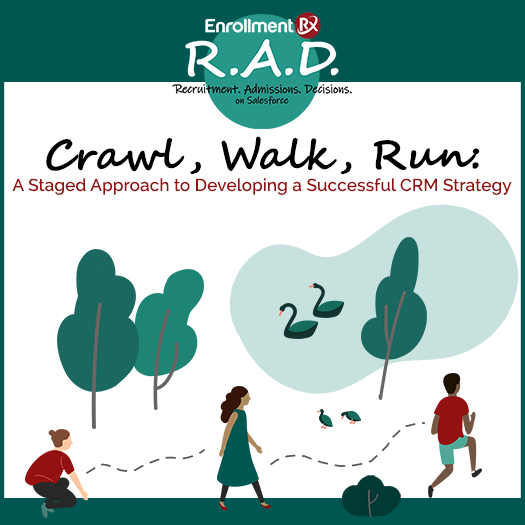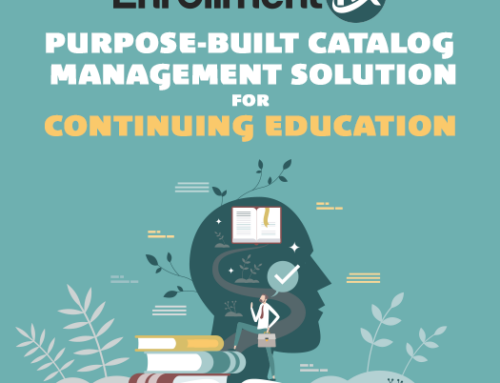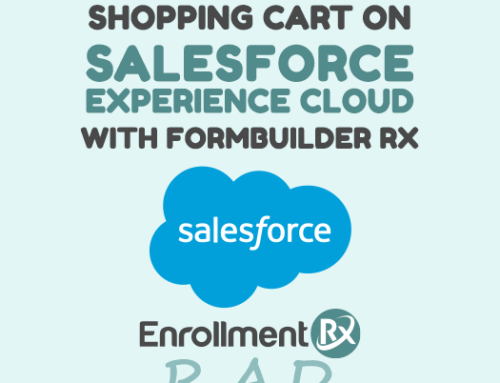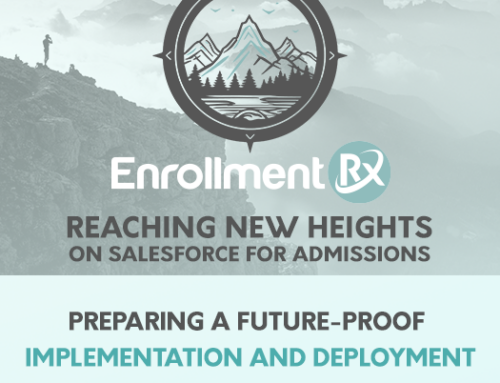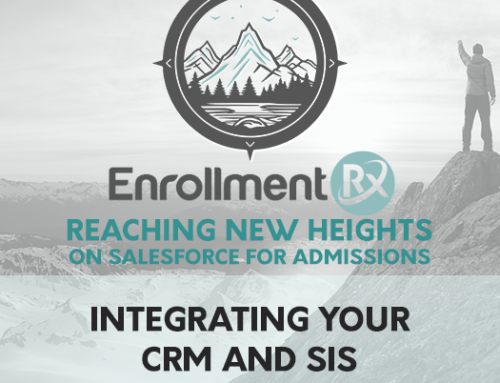Crawl, Walk, Run
A staged Approach to CRM Success
Developing a successful CRM strategy takes thoughtful analysis, a clear timeline of your goals for the project, and a dedicated team who is hungry for success. The Crawl, Walk, Run approach prepares you for an implementation by bucketing your institution’s priorities and identifying your immediate needs. The goal of this method is to help you build a simple framework for jump-starting a plan to implement your CRM, or reevaluate your existing CRM strategy.
Things to consider when developing a CRM strategy
Regardless of where you are in your process and purpose, the first thing you should do is step back and assess the current landscape. Get a clear picture of your resource availability and their knowledge base. Who are the key players, and what skill sets are needed for each part of your project? Are there any  technical skill gaps that will hinder the advancement of the project? Based on this, you can create a game plan with the resources you currently have, or determine if your plan needs adjusting. This may be an opportunity to train your team or hire a new resource with that missing skill.
technical skill gaps that will hinder the advancement of the project? Based on this, you can create a game plan with the resources you currently have, or determine if your plan needs adjusting. This may be an opportunity to train your team or hire a new resource with that missing skill.
If you’re an existing ERX client, think about how you are using Salesforce and ERX today, and how you wish to use it going forward. Do you wish to scale, or would you like to stay where you are and improve your expertise? For non-clients, consider if you want Salesforce to be a standalone system for R.A.D (recruitment, admission, and decisions), or if you wish to expand Salesforce into other departments at your institution.
Next, group together your internal versus external goals. Internal goals involve getting everything into Salesforce and becoming as efficient as possible while improving your staff’s day to day work experience. External goals focus on anything that relates to your target audience. How can the user experience be improved, and what strategies can you employ to allow them to engage with you more? What calls to action do you want your audience to take to draw them in? Evaluating your target audience will allow you to zero in on where you should go next.
CRAWL
Prioritize: As you begin your crawl stage, it’s important to get organized internally. If you’re new to the CRM world, identify your team’s priorities, their pain points, and their wish list of elements in a new system. For those who have been through an implementation, focus on how people’s jobs have changed since implementation and any suggestions they might have for improvement.
Communication: Establish a simple communication strategy, which will be a crucial part of your overall CRM strategy. Continue to ask what purpose does all your communications serve. Are you generating and maintaining interest, eliciting a call to action, or merely trying to inform and update?
Organize: Figure out a simple data model. First, identify all the data that should be living in Salesforce. From there, learn the options for how you can store your data, such as using the education data model architecture (EDA).
Simplify and Streamline: Set the stage for non-Salesforce users and prioritize learning essential Salesforce skills. Focus on the basics of the platform such as understanding user management, creating simple reports, and the fundamentals of communication and tracking.
Customize: It’s important to understand user management and review your org’s institutional security policies. Now that your staff is using Salesforce, do you trust them to add more administrative permissions? You may find that you want to reevaluate and make updates to your existing security structure.
Visualize: Introduce your team to Trailhead, the free online platform for learning Salesforce at any level. Make Trailhead modules a priority and learn hands-on about Salesforce functionality. Encourage users to try their hand at building reports and dashboards. If you’re new to the reporting world, start slow and simple, and build up your skills over time. Thinking about the types of reports your team may find useful is a great place to start.
Standardize and Strategize: All of your data should be captured in Salesforce. It’s time to get rid of spreadsheets and start tracking your phone calls and emails with applicants in the place where they belong; your CRM. Determine what views, reports, and dashboards can be created to make your staff’s 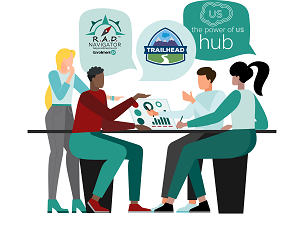 jobs easier in following up on these communications.
jobs easier in following up on these communications.
Diversify: You do not have to go through this process alone. Utilize the resources available to you, such as Trailhead for Salesforce, the Power of us Hub, ERX user guides, and ERX webinars and events. In doing so, you’re setting the stage for a successful journey with your team.
WALK
Communication: Now is the time to refine your communication strategy. Keep in mind the cadence of the different types of communications you are sending out. Utilize different channels for different purposes, such as text messaging, updates within applicant portals, social media, and more.
Evaluate: Now that all your data is in Salesforce, continue to assess the metrics on your various outreach activities. Are you using an email tool that allows you to track engagement? Are people registering for your webinars and virtual visits that you’re instituting? In doing so, you can find the gaps and reevaluate your approach if needed.
Remediate: Use every anniversary of your go-live to identify how things are running. Do a temperature check on your CRM usage and engagement. Review your initial “getting started” documents and identify if there are gaps between what you hoped to achieve versus where you are today. Address those issues and consider the steps you need to take to fill the void.
Facilitate: For those who are still using Salesforce Classic, now might be a good time to switch to Lightning Experience. Salesforce Lightning is a reimagined CRM user experience designed to make processes even simpler and allows users to be even more productive. New innovations to the Salesforce platform are made with Lightning. Because it is the future of the platform, Salesforce and ERX  encourages users to transition to Lightning.
encourages users to transition to Lightning.
Integrate: If applicable, define your integration strategy, or review and enhance what has been done so far. Is all the necessary information from your CRM moving to your Student Information System? Is there information you would like to bring back from the SIS such as student IDs or financial aid information? Are there more advanced integrations that you wish to implement or perhaps integrations with other systems altogether?
Appreciate and Congratulate: Continue to tap into the ERX and Salesforce communities. Learn new skills, enforce those best practices, and find new tools to help your team succeed. Additionally, take time to congratulate and celebrate your milestones along the way. It’s easy to become overwhelmed with everything you wish to do, so it’s important to step back and appreciate the strides you’ve taken thus far.
RUN
All aboard! Find more ways to engage your constituents and continue to share information with each other. Hone in on those items you’ve identified in the crawl and walk stages, and work together to improve those processes.
Get Laser-Focused: Assess your gaps, act on areas of opportunity, and continue to build on what you’ve done thus far. With your team’s growing expertise, are there processes that can be improved or automations that can be added?
Specialize: Are there other Salesforce or ERX functionalities that you haven’t explored yet? For example, try using Events and Visits to its fullest capabilities to get people to visit campus.
Certify: Use Trailhead to gain new skills and work toward certifications for your platform, data model, or your industry specifically.
Scale: Strategize if you want to expand the use of Salesforce to other parts of your campus. Start thinking about what it will take to scale and if you’ll be able to do this internally, or if a consultant is needed.
Getting Started, but Never Finished
 Implementing Salesforce and ERX can be very exciting and rewarding, but the new releases and updated features can sometimes be overwhelming to digest. In order to help alleviate the stress around expanding the use of your CRM, turn to the following tips and resources that are available to you.
Implementing Salesforce and ERX can be very exciting and rewarding, but the new releases and updated features can sometimes be overwhelming to digest. In order to help alleviate the stress around expanding the use of your CRM, turn to the following tips and resources that are available to you.
Trailhead: Trailhead is an easily accessible online learning tool to help you work toward certifications and expanding your Salesforce knowledge. The vast amount of free information can feel overwhelming, so be deliberate about how you choose to spend your training time. Focus on tackling the modules that can be immediately applicable to your job.
Conferences: Both Enrollment Rx and Salesforce hold annual user conferences to help educate and inform clients while facilitating collaboration between users.. The Enrollment Rx “Building on the Best” conference is hosted by a current client college or university. Salesforce holds a number of conferences throughout the year including the global user conference, Dreamforce as well as the higher education specific conference, Higher Ed Summit. The opportunity to attend conferences to learn and network with your peers is invaluable. On the other hand, the vast amount of knowledge being thrown at you over the course of multiple days can be a lot to take in. Know your strategy going into these events, and identify what you plan to leave with.
Analysis Paralysis: If you find that you are overwhelmed throughout this process, grant yourself some forgiveness and start somewhere small. Tackling a few items here and there can boost the momentum to keep pushing through. Identify the low hanging fruit and work smarter, not harder.
Train Each Other: Get your super users together to engage in training the rest of your team. Meet periodically to brainstorm and share knowledge with one another. This includes regular calls with your vendor to answer any questions that come up.
Spend Wisely: If budgets are tight or your priorities begin to shift, take time to reallocate those funds. Maybe take a year off from conferences and use those assets to hire an intern to solve an immediate problem you are having.
Show Them the Money: Stockpile your ROI arsenal to show management how your investment is  producing results. Don’t forget the intangibles and the quality of life enhancements that may not show up in the data. Consider documenting any positive feedback from your team that is a direct result of your CRM implementation.
producing results. Don’t forget the intangibles and the quality of life enhancements that may not show up in the data. Consider documenting any positive feedback from your team that is a direct result of your CRM implementation.
In reality, no one implementation strategy fits all. Different processes are put in place to reach specific goals, which can vary from one institution to another. These tips and best practices are meant to help you create and structure your own crawl, walk, run strategy. Whether you’re at the beginning of your CRM search, or you’re celebrating multiple years with Salesforce and ERX, we hope this assists you on your path to a successful CRM implementation.
